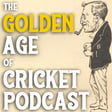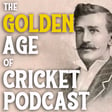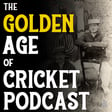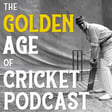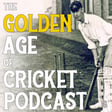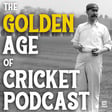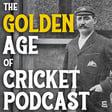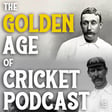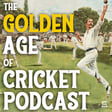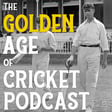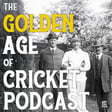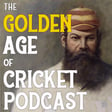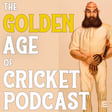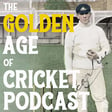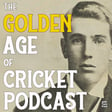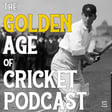Introduction and Overview
00:00:00
Speaker
In the good old summertime, in the good old summertime.
Who was Victor Trumper?
00:00:07
Speaker
Hello and welcome to this episode of the Golden Age of Cricket podcast. My name is Tom Ford. Few cricketing figures prior to World War One hold our attention quite like Victor Trumper.
00:00:20
Speaker
His batting feats, constant humility and devastatingly early death combine to keep him on the pedestal as the bow ideal, as one writer phrased it. A new book has been published which chronicles the final tour undertaken by Trumper to New Zealand in 1914 with a group of fellow Australians, which included the Great Batsman's final first-class match.
Meet Rick Sissons
00:00:44
Speaker
One of the co-authors of that publication joins me today to discuss the tour and Trumper's involvement. Rick Sissons is the author of 11 other cricket books, including The Players, which won the English Cricket Society Silver Jubilee Literary Award, and Billy Murdoch with Richard Cashman, which won the Australian Cricket Society Literary Award.
00:01:07
Speaker
His previous book, When the Kangaroo Met the Eagle, the 1913 Australian Tour of Canada and the United States, with Peter Schofield, won the 2024 Australian Cricket Society Literary Award.
00:01:21
Speaker
His latest book, Trumper Across the Tasman, the 1914 Australian Tour of New Zealand, is also co-authored with Peter Schofield. And Rick returns to the podcast today.
What were the Historical Cricket Tours and their Impacts?
00:01:33
Speaker
Hey Tom, nice to be here. Thanks for joining. um Rick, a lot of my listeners might be familiar with your writing, but recently I've noted that you've made your focus these pictorially splendid accounts of cricket tours, such as your book from a few years ago on the MCC's Tour to Australia 1903-04,
00:01:54
Speaker
and the Australians' tour of America and Canada in 1913, which I just mentioned in the introduction. um What is it about these tours that grabs your interest? Well, i'm I'm particularly interested in that period. um Other books I've written on Duff or Turner all relate to that pre-1914 period.
00:02:15
Speaker
The tours themselves I found quite interesting because um let's start with the 1903-04 MCC tour, which set an important precedent in that this was the um First tour organised by MCC, they took control of it, um whereas previously the tours to Australia had been organised by players, you know that Shaw and Shrewsbury, for example, or had been um teams invited by Melbourne Cricket Club.
00:02:47
Speaker
In Lourdes and the MCC took control and paid the players a fixed fee. And there was some argy-bargy negotiations about this between various players, notably Braund and Johnny Tildesley.
00:03:03
Speaker
Now, that set a precedent for the Australian Cricket Board, which had been recently formed, to try and take control of Australian tours to England, which up until that point had been run and controlled, managed, and the profits shared by the players themselves. um And they progressively, but the Australian Board began to take control until in 1912, you had the famous Big Six dispute where Trumper and five other players refused to tour because the Australian board said you can have, basically, you can have any banter you want for the tour, but it cannot be Frank Lever for some reason.
00:03:42
Speaker
So then... um What you have after that are these two separate tours um organized 1913 to North America by an entrepreneur in the US, Benjamin, um who had helped the 1912 Australians back through North America.
Arthur Sims and the 1914 Tour
00:04:04
Speaker
And again, that was ah not under the control of the Australian cricket board, but was organized by the players. um And then in this tour to New Zealand was exactly the same in 1914. Arthur Sims, who was you a good first class player in New Zealand, um but was a successful businessman.
00:04:28
Speaker
he made an offer to the New Zealand Cricket Council that he would pay for and organize a tour of Australians to New Zealand. So that's the overarching theme of all of these tours is um confrontation with the boards, I guess, and also controlled by the players.
How is Research and Imagery Important in Cricket Literature?
00:04:47
Speaker
So your your current release or the book that's just been published, Trumper Across the Tasman, which focuses on the 1914 Australian tour of New Zealand, um it was co-authored ah with another Sydneysider gentleman called Peter Schofield, um as was your previous book, and The Tour of America and Canada.
00:05:09
Speaker
Can you explain your relationship with Peter and how the collaboration works in the sense of putting a book together? Okay. Well, but Peters, um as you may know, is one of Australia's most notable cricket collectors. Got a huge yeah a collection of memorabilia, but all pre-1914, and particularly a Victor Trumper material. He's authored some books ah of his own on Trumper and that period and on one's ah on postcards and other cigarette cards, memorabilia from that period.
00:05:43
Speaker
So in his own right, he's a well-established um author, um but he's also very generous with his time and, you know, time and ah materials and happy to let people use the materials in his collection. That's how I first came across him.
00:05:59
Speaker
Um, so basically the division on these books is I predominantly do the research and writing and Peter does a lot of the work on the imagery. Um, and then we've also on these last two books been working with a really good book designer.
00:06:15
Speaker
you know We really want these books to be beautiful pieces of work, to be honest. And these two books, I think, are that. you know They're lovely, large format hardbacks with very large imagery, um which really yeah speak to the period.
The Impact of Overseas Influence on New Zealand Cricket
00:06:30
Speaker
Yeah, and i'm I'm assuming, Rick, that, I mean, correct me if I'm wrong, but Peter might produce a postcard or ah or an image that you hadn't seen before, which then might fuel further research. Is it a collaboration in that sense? Yeah.
00:06:47
Speaker
Yes, well, so on both of the books, we were fortunate in finding um other collections, um say, from on the North America book, um there were some beautiful glass plates from um one of the libraries in Philadelphia, which hadn't really been used before, and they reproduced fantastically well.
00:07:07
Speaker
um On the 1914 book, of course, we had access to Frank Labour's collection, which is at the Melbourne Cricket Ground, which again is a tremendous resource that was donated to the ah Melbourne library ah mobile Cricket Ground Library.
00:07:22
Speaker
And also because Labour was on the 1914 tour, he often gave photographs to the players who produced um small books and booklets that they gave to other people. So finding images in those collections then in turn led to us down you know more detail and information about particular aspects of the tour.
00:07:42
Speaker
So what did you already know about this 1914 tour of the Australians to New Zealand? It happened right before the outbreak of the First World War. um i mean, it is known. i mean, after he died, it just became known as the last tour that Trumper undertook. But ah what did you unearth in your research in preparation for this book?
00:08:05
Speaker
Well, you know I mean, we we knew about the 8th wicket, famous 8th wicket stand. um I hadn't realised, I mean, I hadn't really paid, I suppose, i must say, that greater attention. I didn't realise that this was actually on that tour Trump had paid his last first-class...
00:08:22
Speaker
ah match um because when he came back after that tour, he didn't play first-class cricket again. He played about six club matches before he became very ill. He played four for Gordon and two for ah some scratch side.
00:08:37
Speaker
um I hadn't realized, therefore, this last first-class match was in New Zealand, which is obviously quite significant. And I hadn't also realized um until I did the research on it that the tremendous influence of overseas coaches in New Zealand, much more so than in Australia at the time. I mean, Australia originally had the um ah influence of coaches like Charles Lawrence from the 1870s and 80s and actually through the 1890s. He continued to coach as an old man in Melbourne.
00:09:07
Speaker
But um in the 1900s, it wasn't the same. In New Zealand, every major association there seemed to have an imported coach, and most notably, say, Bert Relf, who played for Sussex and England, was coaching there.
How did New Zealand Cricket Develop Pre-Test Nation Status?
00:09:23
Speaker
Jack Bord, who who from Gloucestershire, the wicketkeeper from Gloucestershire, he was coaching. And even um Saunders, um who played for Victorian Australia, uh, got a job coaching. He's got a job as coaching and as groundsman at Wellington. Although in the end, he really was only working as a groundsman. Apparently after the first year, nobody particularly thought much of his coaching and poor old Staunders didn't get any clients, but, um, that, that was quite striking. The influence of overseas coaches and Dan Reese, the, who will come on no doubt to talk about who was the captain of New Zealand.
00:09:59
Speaker
Um, He wrote about that that, the tremendously important influence of overseas coaches on the game in New Zealand. So that that was all um something that I hadn't really um been aware of until we began to put this book together.
00:10:16
Speaker
Yeah, and I will be the first to put my hand up and say I knew very little about this tour. um I knew the famous partnership, as you as you mentioned, and we'll get to later, but it is a very illuminating so study, I have to say. Not only beautifully produced, um but there are a lot of little pockets that are there to be discovered um and very well put together. So, Rick, before we...
00:10:42
Speaker
Before we dive further into the actual tour, I was wondering if you could give us a bit of a lay of the land of New Zealand cricket in and around 1914.
00:10:53
Speaker
they They weren't a test playing na nation at this stage, but what was the quality of their players and of their first class matches? I suppose one interesting way you could look at that point was um in nineteen in the Australian season, 1913, 1914, there was actually a tour to Australia by New Zealand team, which was pretty much, um it was captained by Dan Rees and um included most of the players who then appeared in the the series against the Australians in 1914 in New Zealand.
00:11:28
Speaker
in new zealand One omission which is quite controversial was they didn't include Clary Grimmitt, who was just making a name for himself in Wellington, and they preferred a couple of older spin bowlers.
00:11:40
Speaker
But um it was, yeah from New Zealand's perspective, quite a strong side. um They beat Queensland, um and as you probably are aware, and Queensland at the time wasn't in the Sheffield Shield, and Queensland and Tasmania, when New South Wales and Victoria played Queensland and Tasmania, they basically sent their second eleven But this New Zealand side beat Queensland. But then they played New South Wales and Victoria and they lost very heavily in two days by an innings to both of them.
00:12:08
Speaker
And against New South Wales, Trump has scored a big century. um I think it was a double hundred. ah So that's sort of um indicative that the last game of the tour, they did draw with South Australia and Dan Reece scored a century.
00:12:24
Speaker
But I suppose that's one way of measuring. you know they The New Zealand side wasn't of a standard of the strong Australian state sides. Let's put it that way.
00:12:37
Speaker
Cricket within New Zealand seemed to be very rivalrous and competitive between Auckland, Wellington and Christchurch were the three big centres. um And that rivalry really um ah was problematic throughout the...
00:12:53
Speaker
period we're looking at of you know the 1900s in New Zealand they course did have the Plunkett Shield by then that had been set up in the nineteen hundreds yeah um and that seemed to be basically ah ah was from that period from about 1907 to 1914 was basically won by either Christchurch or Auckland but they didn't play ah genuine round robin competition where every first class association played the other associations, you know, home and away until the nineteen twenty s So it was a very strange competition.
00:13:28
Speaker
um And it wasn't until the early that cricket was reorganized in Christchurch in the same way as the Sydney Great competition was organized along the lines of electoral districts.
00:13:41
Speaker
Now, remember, in Sydney, that had happened in the 1890s. So this was, I think, 1905, 06, and cricket in Christchurch began to be organised in a much more competitive way, organised around electoral districts. So I suppose, you know, where are they at? They're, you know, so some way behind Australian cricket, there's no doubt, but there they're improving all the time. And various tours that happened...
00:14:06
Speaker
um People did speak when they came back to about the improve you know the game was improving New Zealand. There's no doubt about that. Yeah, and improving ah often off the back of these Australian tours. So we're talking about the 1914 tour today, but um it certainly wasn't the first tour that Australians had led to New Zealand. ah Your book, Case in Point, actually begins with a recap of the 1905 tour australian cricket team who first toured new zealand on their way to england for the 1905 ashes um just as a bit of a understanding for our listeners today how did that tour unfold how did the australian team fare in new zealand um and how did it also compare with the mcc's tour because we can't forget that england players often came to new zealand how did
00:15:03
Speaker
The 1905 Australian tour compare with the MCC's tour of New Zealand in 1906-07.
Significance of Private Tours in Cricket's Early Development
00:15:11
Speaker
The 1905 Australians went to New Zealand before they went to so en route to England. So often there'd be tours to New Zealand or could be either tacked on either end of tours, you know, which...
00:15:24
Speaker
really wasn't very satisfactory for New Zealand. um The 1914 tour is notable because it was the first really genuine tour of New Zealand, which covered both North and South Islands and every major city. So it was quite unique in that sense.
00:15:41
Speaker
um I mean, 1905 tour, up to obviously with the Australian side, it's interesting because it's all, again, about Trumper. yes It's interesting. You see articles in the paper and comments and pictures with it.
00:15:55
Speaker
the He's just considered the world's greatest batsman. Time and time again, you see newspaper references to that. um Interestingly, the captain of New Zealand, in when that side was there, was Arthur Sims.
00:16:08
Speaker
ah The point about that is is that Sims, who in 1914... wants to organize the tour of ah New Zealand is already on good terms with the likes of ah Noble, Armstrong, Leyva and Trumper because they were all in New Zealand in 1905 when he was the captain of the New Zealand side.
00:16:29
Speaker
um So that, you know, network begins to um form a bit but around that time. The MCC tour in 1906-07, I wouldn't say it's a joke, but I mean, they just sent a bunch of um amateurs who were predominantly Oxford and Cambridge graduates.
00:16:49
Speaker
And it was really, you know, they had a great time. the was I wouldn't necessarily the cricket was great, I can't, but you know that all the reports out of it in the book that was written about the tour by one of them, who members of the tour, just speak about them having a wonderful social time.
00:17:06
Speaker
And I think they um cost the New Zealand Cricket Council quite a lot of money unexpectedly in the amateur's expenses, in inverted commas. right So that, in a sense,
00:17:19
Speaker
sums up sadly the mcc's attitude to developing the game and you see the same in north america there the mcc or never organized a proper tour to help promote the game in north america um and likewise in new zealand so you know you begin to well how serious were they or did they ever consider how important it could be to develop the game around not around the world really around you know the red parts of the empire, as someone once said in 1914.
00:18:07
Speaker
It is also, um you know, we're still in that period where some of these private tours are still being organised, trying to be organised and um we we can't think of this period like we do through modern eyes where everything is official and it's the England cricket team, the best players going to a part of the world. I mean, it happens in the 1890s with ah so-called English cricket team going to South Africa but it's, like like you say, it's a second 11 and um
00:18:38
Speaker
And a bit like what you mentioned before with, you know, New South Wales going up to Queensland, it's New South Wales, but it's really a second XI side. So um it's it's just par for the course during ah this pre-World
Who was Dan Reese?
00:18:51
Speaker
War. That side the MCC sent to New Zealand in 06-07 would it even be the second, it would be the 50th It was really such a poor side, you know. i mean, it was clearly them having...
00:19:06
Speaker
amateur a bunch of amateurs having an enjoyable time in New Zealand. you know Yeah. but's it's I mean, it sounds great. i mean I wouldn't knock back a trip to New Zealand either, to be honest. so um Rick, one of the um notable attributes of your tour books are these spotted miniature biographies which appear throughout, ah particularly of lesser-known cricketers or even ah cricket administrators, just to help colour the picture of the tour that we're dealing with.
00:19:38
Speaker
One of the first which appears in this 1914 tour book is of Dan Rees, who you've already mentioned and is often regarded as the father of New Zealand cricket.
00:19:49
Speaker
Can you tell us a bit more about Dan and his place in ah the cricketing landscape? Yeah, he's a really interesting um person um who was a schoolboy at the same time as Sims, went to the same school very early on, shortly after they um left school. They both um what went on a tour from for the Canterbury Association of the North Island in 1897-98. So so here we
00:20:20
Speaker
again you begin to see this network um And Rhys was a very good left-arm bowler. um He scored a century in 1903 against Lord Hawke's 11, captained by Warner.
00:20:38
Speaker
um But he... could never afford to play as an amateur anywhere. he he was from a family, there wasn't in any position to do that. And he went to technical college, got qualifications as an engineer, and then became a marine engineer and traveled to um England.
00:20:58
Speaker
He'd also been in Melbourne working for an engineering company where he met Warwick Armstrong um and he played for the Melbourne Cricket Club. He went to England to continue his working career.
00:21:11
Speaker
um when When he had time, he played um with Graces, London County, by which time they were playing basically club matches. now And he also did play a few games for Essex in 1906. So um he was already yeah a highly thought of and capable cricketer for sure, but he'd also got experience um overseas and he was a successful, he came back and joined his brother Tom and set up a very successful business um in in and around Christchurch.
00:21:46
Speaker
but you know he's he's a person who you know so look when they're talking about the business you know they used to go on their bike and ride around all the plumbing shops to sell stuff you know he was very down-to-earth sort of person and um he then became captain of the New Zealand side in 1914 for the when the Australians came and after that tour basically retired but his role in Zealand cricket was hugely influential beyond that as a selector administrator and part of you know the what did the NCC got the Imperial Cricket Conference if that was what it was called the ICC so very significant figure but
00:22:29
Speaker
again, um part of this sort of network of Australian and New Zealand cricketers who, and particularly, you know, the Sims Noble connections, which made it possible to put together this unofficial and inverted commas tour in 1914.
Smaller Tours and Cricket Relations
00:22:47
Speaker
Yeah. Now, we've already mentioned and some of the previous Australian tours to New Zealand, notably the 1905 one, which was just tapped on, as you say, en route to England. But there were a few other smaller tours arranged to New Zealand, which is again covered in your book,
00:23:08
Speaker
Two of those I'll mention now. So in 1910, there was a tour led by Warwick Armstrong. And we know Warwick, who's a ah you know routinely mentioned on this podcast, would just play any match available. He just loved being on the cricket field.
00:23:24
Speaker
um And then there was another a small tour to New Zealand arranged in 1913. um and this one was, this surprised me actually, was captained by Harry Trott.
00:23:35
Speaker
um Harry's been the subject, a recent subject on this podcast. And I say that with surprise because at this point in his life, he's ah not playing much cricket. He's had a, you know, a spell in an asylum and he's not playing test cricket anymore. So I'm quite surprised to see that Harry led a tour to New Zealand.
00:23:56
Speaker
What can you tell us about these two tours, the 1910 and the 1913 one? or the nineteen ten tour and the nineteen thirteen one Well, the 1913 one led by Harry Trot, when I think he must be in his mid to late 40s by this point, um was the um was the South Melbourne Cricket Club tour. So they were basically playing club matches there.
00:24:20
Speaker
At the same time, there's also and another rather strange show, which I was never not aware of in any way before i started working on this book, the New South Wales Teachers Association,
00:24:32
Speaker
used to tour the New South Wales teachers cricket team regularly toward New Zealand in the summer holidays. um And they would alternate between touring South Island and the North Island. And this was a tour organized by and a man called Frank McMullen, who was a notable delegate on the New South Wales Cricket Association and a great friend and ally of Victor Trumper.
00:24:54
Speaker
i' Sorry, Rick, were they playing other yeah teachers against New Zealand teachers? No, I think there were, yes, they were. They did play on other teachers, but they also just played club matches, you know. So there was this, um there were tours going backwards and forwards, as you say, and there was the 1910 side, which is a very strong side, captained by Warwick Armstrong, including Hopkins, Bardsley, Sid Emery, Bill Whitty, Charlie Calloway. So that was a very strong side. They played against Canterbury.
00:25:24
Speaker
I can't remember the result, but I do remember that ah Dan Rees scored 108 against them. um Armstrong's view when he came back was having been there in 05 and then in 1910, he thought New Zealand cricket was um improving quite considerably.
00:25:44
Speaker
The other comment, all these people, all these but when they came back, they were always interviewed by the press, so there's you know bits and pieces, but they all thought thought the wickets were too slow, and that was a recurring theme throughout this period. It was also a comment made by Monty Noble that the wickets were too slow and you know they needed to improve the wickets. There needed to be faster wickets if the game was to you know make progress well at first-class level in in New Zealand.
00:26:13
Speaker
The 1910 tour though came very close to being cancelled, which was quite interesting because um in fact the New Zealand Cricket Council did at one point send a telegram to the Australian board to cancel it, two weeks later um after after being you berated by the Australian cricket board and recanted and the tour went ahead.
00:26:33
Speaker
and was only just, you know, happened only a few days before the players were due to leave. right But it was all about the different rivalries between the different associations in New Zealand and how this was to be paid for and Wellington disagreeing with Canterbury and so on and so forth. So um that rivalry, again, is a theme that recurs over and over again within cricket in New Zealand at this point.
00:26:56
Speaker
Interesting. um Yeah, now we've... Oh, one funny thing, by the way, sorry, about Harry Trott when he was there. They played against Clary Grimmett, Harry Trott said. And obviously Grimmett was still quite young then, only just beginning to emerge in Wellington. But it was interesting that Harry Trott noted that ah Clary Grimmett, who eventually, of course, came to Australia and played test cricket for Australia,
00:27:20
Speaker
ah The um other thing besides the slow pitches Harry Trott mentioned was temperance. Temperance was very strong in New Zealand at this time. And there were a number of cities where um ah there was no alcohol at all.
00:27:34
Speaker
Although Harry Trott said they never had any problems finding any. So, you know, I suppose that's... It's just the power of being a top-level cricketer, I suppose. I suppose
Influence of Players like Clary Grimmett and Overseas Talent
00:27:45
Speaker
that's right. Overseas cricket teams can always find their way to the Alcon. Yeah, that was quite interesting. I wasn't aware that temperance movement was so strong in New Zealand at that time.
00:27:55
Speaker
Neither did i um And it is interesting, you mentioned Clary Grimmett, and you know most cricket fans, I assume, are aware that he was born in New Zealand. But what comes across in your book, because towards the end, when you're talking about legacy, and you you do a little profile on Clary, and it sort of reminded me, I was aware, but I often don't have it at the forefront of my mind. I mean, he's not a cricketer who was born in New Zealand, came to Australia as a youngster and learned his craft there. I mean, he was, he was um you could say, an established cricketer in New Zealand before he emigrated to Australia and became one of the all-time great leg spinners. It was it was a refreshing reminder, I have to say, which was featured in your book,
00:28:42
Speaker
Yeah, that's true. um um As I said, you know, there was some consternation why newsy why he wasn't chosen to go on the New Zealand tour in 13, 14 to Australia.
00:28:53
Speaker
Then he did play um for Wellington and he did play for New Zealand at least once against the Australians. In Wellington, he played with Jack Saunders, you know, the Victorian and Australian bowler from the nineteen hundreds um And Grimm does credit um ah Saunders with you know coaching and helping him.
00:29:16
Speaker
But you're right, by the time he came to Australia, he was a well-established first-class cricketer. Another
The 1914 Tour: Organization and Challenges
00:29:23
Speaker
cricketer, you know you mentioned coming to Australia. We've mentioned him already as Arthur Sims.
00:29:30
Speaker
So how how instrumental was he, Rick, in actually getting this 1940 tour to New Zealand off the ground and past the cricket authorities who often didn't want, you know, were we're trying to prohibit this or at least make the tour come under their auspices. how How influential was Arthur Sims?
00:29:52
Speaker
Well, the tour wouldn't have happened without him. And basically, it was a fait accompli. um The Australian board was presented with a fait accompli. It was organised and going to happen in the end, whether they approved it or not. And subsequently, they did um ah say that was OK. They felt that they blamed the New Zealand Cricket Council that it's sort of basic said kept them in the dark about all this. And they didn't want to penalise the players who'd already committed to go.
00:30:22
Speaker
What had happened in these previous years was the New Zealand Cricket Council tried on many occasions to get tours organized to New Zealand. They'd approached New South Wales, they'd approached Victoria, they'd ah even approached Tasmania as well.
00:30:36
Speaker
And they were all, they get no and all the time. They were just being rejected. And they tried to get um ah the MCC to agree to tack matches on when um sides came to play in the ash play for the Ashes in Australia. Again, the MCC said no.
00:30:53
Speaker
So Sims went to the New Zealand Cricket Council and said, basically, I'm prepared to organize this. I'm prepared to pay for it. um Let's do it. And you've got to remember Sims at this point, um again, like Reece, he's built his own business off.
00:31:13
Speaker
He's a very strong laissez-faire capitalist. yes And he built a large business up shipping frozen lamb from New Zealand and Australia to Britain.
00:31:25
Speaker
um because at that point you'd now got um ah shipping which was capable of carrying frozen meat. So he'd made a lot of money doing this. He'd also given me a lot of connections.
00:31:36
Speaker
And you because he was a you know good cricketer in his own right, he already knew um Noble, Lever, Armstrong. ah He knew Reith very well, obviously, because they'd been and playing from schoolboy level together.
00:31:52
Speaker
Um, so he was really capable of doing this. Um, in a way I mean, not quite the same, but there's sort of something Packer esque about him, you know, he was going to do this and run it and take it on. And the Australian board, well, they could, you know, take it or leave it, but it was going to happen.
00:32:10
Speaker
So, He had all the connections um to put it together, and he did, and ah signed you know got all the players signed up. But you've also got to remember that Noble had retired from international cricket in 2009.
00:32:27
Speaker
Armstrong had been... forced out of the captaincy of the Victorian side in a coup d'etat. um Trump had been part of the Big Six.
00:32:40
Speaker
So the ground was there. You know, these players were more than happy. They didn't feel any great allegiance to who the Australian cricket board. Frank Laver, who Sims really liked and thought was a great manager, had been told that, you know, we're not having you as manager of the 1912 tour to England.
00:33:02
Speaker
You are persona non grata. So, you know, the ground was there for Sims to sow the seeds of this this tour, which he did. And, um you know, in the end, the Australian board and had to agree to it. that the The Australian board's attitude, the one question they were obsessed by was they wanted to know from the New Zealand Cricket Council who was paying the players and how much were they being paid.
00:33:29
Speaker
And the New Zealand Cricket Council's response was, well, we don't know. You better talk to Arthur Sims. But that issue about who, it's, you know, it's the whole issue for the Australian board payment about who's paying players payments, how much, and it's outside of our control.
00:33:47
Speaker
Yes, and of course with Frank Laver being on tour as well and all the rupture that he had caused or been involved with the Big Six, that must have ah raised some eyebrows as well. But definitely a marketer's dream um for New Zealand with Trumper and Noble effectively coming out of retirement and Warwick Armstrong, all very big names.
Social Aspects and Memorabilia of Early Cricket Tours
00:34:13
Speaker
Yeah, it must have been great for New Zealand audiences to know that... or crowds to know that those names were coming to their shores. Absolutely.
00:34:23
Speaker
I'd like to find out as I said before, said before, said before. Oh, won't someone please kindly put me at ease?
00:34:42
Speaker
Rick, one of my favourite things about the Golden Age, the so-called Golden Age, is looking at team photos because there's nothing uniform about them. I mean, if you look at some of the county photos, you've got amateurs and players in their order, but they're wearing a mixture of boater hats and skull caps and various blazers and you know, if you're CB Fry, you're wearing whatever you want to um And this the same thing happens in Australia as well, probably not to such a degree, but um you include in your book of this 1914 tour, one of my all-time favourite photos, and I'm sure you know which one it is. It's the team...
00:35:22
Speaker
The Australian team gathered together. It looks like it's on a riverbank. There's some trees behind. um And it is just an absolute mixture of dress and personnel. There's um there's two wives included in the photo, um Monty Noble's wife and Warwick Armstrong's wife.
00:35:42
Speaker
um And then again, you get them wearing all sorts of things. I think they're wearing their state blazers or a mixture of some are wearing Australian blazers. um But what's interesting as well is that this photo really represents um almost the passing of an age. You've got the veterans that we've already mentioned, Noble, Laver, Armstrong and Tromper.
00:36:05
Speaker
But then you've got this new generation coming through. You've got a young Arthur Maley, Jack Crawford and Burt Collins even is on tour. So let's talk about the actual team that made it to New Zealand. um What are your thoughts on the makeup of that squad?
00:36:23
Speaker
Well, let me say, i agree. I think this is a beautiful photograph. I mean, it's, um, some of these team photographs, yeah i mean, it reminds me of the photographs that used to be taken of the English tourists in Adelaide in the botanical gardens. There's some beautiful photographs taken there.
00:36:40
Speaker
And this is the same. It was taken in, in Christchurch, um, in a park, probably as you say, ah a riverbank, that beautiful background. ah It's a stunning photograph. The interesting point that you make there um is that that team in 1914 didn't have um blazers, caps, um or any uniform. of so The 1913 team to North America had, when you see them photographed, yes they they had cap badge, they had a blazer badge, and they had all the correct gear.
00:37:10
Speaker
This team, because it was only only put together for a tour of um two months, they They were just wearing whatever badges and blazers caps they wanted to take.
00:37:21
Speaker
So you do get that assortment, as you said, which is it makes it quite an interesting... I actually like that about this. It's charming. is it Yeah, exactly. Perfect. Charming. Yeah, it is a really charming photograph.
00:37:33
Speaker
adding the wives in his brilliant to bill ferguson's there as well yes the scorer and um a slightly mysterious fellow called bill mccall who's the assistant manager who couldn't really find much about but he actually played in one game um when they were a player a short uh early on uh so everybody who was on the the whole group is in the photograph everybody you know um yeah the interesting point that that
00:38:04
Speaker
There's a generational check, you know, you've got the older Noble and Armstrong and then Meili, who by that point i don't hadn't played for Australia, but was taking a lot of wickets for Redfern and had got forcing his way into Nisaklal's side.
00:38:21
Speaker
um Collins and Cody, Bert Collins and Les Cody had been playing together um and played rugby league together actually um for Eastern Suburbs for a few games had opened and ah were on the fringes of the New South Wales side. and Collins obviously becomes much more established than Les Cody.
00:38:44
Speaker
And Jack Crawford, who was a prodigious talent, who'd been played for Surrey as a schoolboy um and then was forced out of the Surrey side and out of the and outed the England side as well, for that matter, um and emigrated to South Australia, um where he was... um a great presence in the South Australian side, helped them win the Sheffield Shield.
Victor Trumper's Final Days in Cricket
00:39:09
Speaker
yes So there was a new generation of younger players and the older players, plus you know the why the two wives, the scorer, Bill Ferguson.
00:39:19
Speaker
um So you know everybody who was on the tour was in this beautiful photograph. The notable absentees, um ah Warren Barzi, I don't know why he wasn't on the tour. He'd gone to North America the previous year. He'd been incredibly successful in 1912 in England, along with Charlie McCartney.
00:39:38
Speaker
McCartney was on the 1913 tour of North America as well. um What I did, there was references in the paper. McCartney, felt that um it might damage his relationship with the Australian board if he went on the tour of um New Zealand.
00:39:54
Speaker
And he obviously had some aspirations to be captain, I think, of Australia at some point and didn't want a detrimental relationship with the Australian board. What's interesting about ah Bardsley's absence is he's a bit like ah Armstrong in that he just loves to play cricket. I mean, any opportunity. So it does make it all the more peculiar that he's not on this tour. So Rick, let's talk about Victor Trumper and I'm sure many of the Listeners today are keen to hear about Trumper's efforts on this tour. um
00:40:28
Speaker
It was a surprise to many, reading your book, audiences and crowds and administrators, that he actually made the trip to New Zealand, having not toured England in 1912, as you said, um or in the any of the previous tours to New Zealand of the recent years, such as 1910. So how was Victor Trumper placed in 1914, both from a health perspective, but also a cricketing one? Yeah, undoubtedly, I mean, Trumper was a phenomenal player, but compared to 1902 or 1905, he's beginning to
00:41:06
Speaker
Wayne slightly, slightly, use the word reservedly because he was such a fantastic player. Um, but there must have, there was speculation that when he was ill, he actually had tuberculosis. This, he did in Hayes view, um, in his book on trumpet that he probably had TB.
00:41:23
Speaker
and he probably didn't really ah hadn't really recovered from that and this was lingering. But um you know if you look at the photographs in this period, 1913-14, the New South Wales side pictures, for example, he does not look well.
00:41:36
Speaker
um yes he's he was late He pulled out of the 1913 tour of North America at the last minute. That was a longer tour. um And also, the testimonial just happened he got things he needed to finish his business. This hadn't been going well.
00:41:52
Speaker
um And his wife was expecting a second child in 1913. thirteen team That was all, to some extent, behind him in 1914. And this was a shorter tour. It was only two months.
00:42:04
Speaker
He didn't arrive until the fourth match. His wife had been ill. He didn't leave with the other players. um businesses by this point seem to have been sorted out. According to Ashley Malick's book, he was actually just working as a Thai salesman by January 1914. So I suppose things were much more stable from that so point of view.
00:42:26
Speaker
um But, you know, as we know, um this incredible innings he played in 293 was, you know, in a sense, his last great hurrah in terms of his Christian career because, you know, she was dead one song swa song yeah exactly because he's dead the following year.
00:42:45
Speaker
But in in New Zealand, this is who they wanted. I mean, it would have been terrible if he had pulled that yeah pulled out of that tour. You know it was who everybody wanted to to see. I mean, Arthur, mainly when he got back, um,
00:42:59
Speaker
from the tour, gave an interview to the referee where he said everywhere they went, people wanted to know where who's Trump, who's Trump, or where's Trump at, at railway stations, everywhere.
00:43:09
Speaker
And to take the pressure off Trump, Meili says that everybody on the team at one point or another had to play the part of Trump. Now, Arthur Mealy's stories, one always has to take with a pinch of salt. But sure this wasn't Mealy writing his memoirs years and years later. This was Mealy a month after the tour. So I think there was probably ah ah that was probably true.
00:43:34
Speaker
And you know that that's who the crowds wanted to see. And when he was out, they were disappointed. you know Similar to the whole Bragman thing. They turned up to see Bragman when he was out. They left. you know Similar thing. You get the impression with Trumper as well.
00:43:47
Speaker
Yeah, and little did they know that, of course, 18 months later, he would ah he would be dead. All very sad. ah Exactly. Yep. Tragic.

